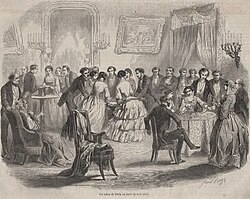
Back Tischrücken German Mesa giratoria (espiritismo) Spanish Table tournante (spiritisme) French Asztaltáncoltatás Hungarian Mesas girantes Portuguese Borddans Swedish Masa çevirme Turkish
| Part of a series on the |
| Paranormal |
|---|
 |
Table-turning (also known as table-tapping, table-tipping or table-tilting) is a type of séance in which participants sit around a table, place their hands on it, and wait for rotations. The table was purportedly made to serve as a means of communicating with the spirits; the alphabet would be slowly spoken aloud and the table would tilt at the appropriate letter, thus spelling out words and sentences.[3] The process is similar to that of a Ouija board. Scientists and skeptics consider table-turning to be the result of the ideomotor effect, or of conscious trickery.[4][5][6]
- ^ L'Illustration 1853-05-14, retrieved 2020-02-29
- ^ Geoghegan, Bernard Dionysius (2016-06-01). "Mind the Gap: Spiritualism and the Infrastructural Uncanny". Critical Inquiry. 42 (4): 899–922. doi:10.1086/686945. ISSN 0093-1896. S2CID 163534340.
- ^ One or more of the preceding sentences incorporates text from a publication now in the public domain: Podmore, Frank (1911). "Table-turning". In Chisholm, Hugh (ed.). Encyclopædia Britannica. Vol. 26 (11th ed.). Cambridge University Press. p. 337.
- ^ Rawcliffe, D. H. (1987). Occult and Supernatural Phenomena. Dover Publications. p. 137
- ^ Zusne, Leonard; Jones, Warren H. (1989). Anomalistic Psychology: A Study of Magical Thinking. Lawrence Erlbaum Associates, Inc. p. 110. ISBN 978-0-805-80507-9
- ^ Robert Todd Carroll. (2003). The Skeptic's Dictionary: A Collection of Strange Beliefs, Amusing Deceptions, and Dangerous Delusions. John Wiley & Sons. p. 172. ISBN 978-0-471-27242-7